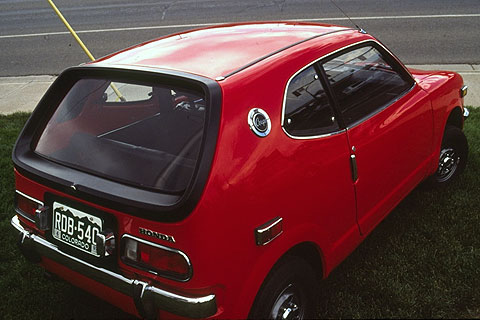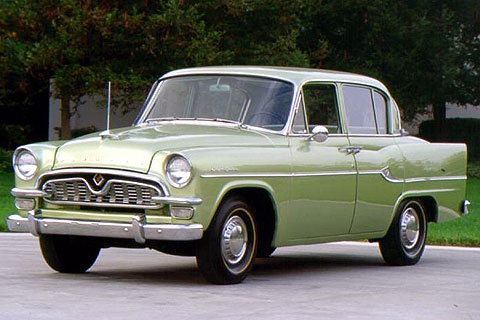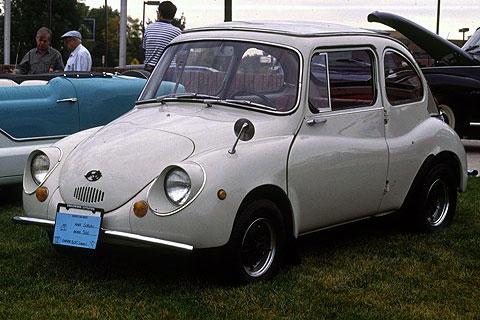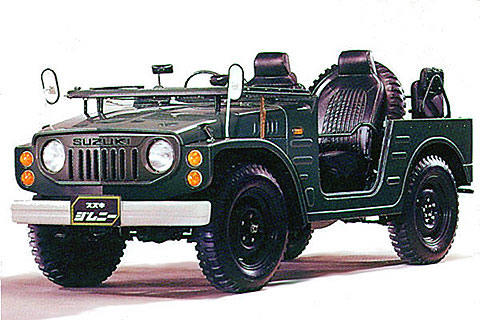The first postwar Japanese cars were spartan and simple to keep prices affordable. Very poor Japanese roads meant that while cars had to be rugged, they did not need not be fast. The tax structure favored Kei Jidoski microcars with under 360 cc engines and no longer than 3-meters (118-inches.) They were also exempt from mandatory overhaul and owners did not have to prove they had a place to park before they could make a purchase.

|
| Top speed of the Honda Z Coupe was a couple mphs more than the N600 because of its somewhat better aerodynamics. |
Honda did not start building cars until 1962 when it was already the world's largest manufacturer of motorcycles. Not surprising, its initial series of cars, the S-500/S-600/S-800 two seat sport cars, inherited many motorcycle features. The S-600 and S-800 were imported in limited numbers.
By 1966, Honda had joined Japanese 360 cc market with its N360 mini-car featuring a 354 cc, 31 horsepower two-cylinder engine driving the front wheels. When Honda entered the American market in late 1969, it upgraded the Honda 360 with a 598 cc engine for the N600. The engine produced 35-horsepower though N600s marketed in Hawaii had 45-horsepower.
The standard transmission had four forward gears and used a shifter that projected out beneath the dashboard. To meet the American's desire for shiftless driving, a three-speed, Hondamatic was optional. All this was packaged into a two door, four-passenger sedan that was only 125-inches long.
In 1971, the N600 sedan was joined by the Z coupe. While using the same mechanicals, it had, according to Honda, a more "sporty" body. The 2+2 coupe was a couple of inches shorter in length and height. These were followed by the Honda Civic, Honda's first successful car on the American market.

|
| The Toyopet Crown found few buyers in the U.S. |
Toyota's first venture in the U.S. was Toyopet Crown in about 1957. This was a near luxury, compact, 4-door sedan with a 1500 cc 4-cylinder engine. Sold mainly in California, it was a flop, partly because of its weird styling. This was followed in 1958 by the Land Cruiser. This was a success with models like the FJ-40 still coveted by 4WD enthusiasts. Indeed, the 2007 FJ Cruiser borrows styling cues from the FJ-40.
Nissan, then called Datsun, got started in the U.S. with a series of rather successful sports cars. These were 1962–64 1500, 1965–70 1600, and 1967–70 2000. Called the Fairlady in Japan, they looked a lot like the contemporary MGB. However, they outperformed the British roadster when it came to refinement, fit, finish, and reliability. For example, the 2000 had a five-speed, all-synchromesh, Porsche-designed gearbox and a single-overhead-camshaft four-cylinder engine. Most of the 40,000 of these sports cars came to the U.S. and set the stage for the outstanding Datsun 240Z.

|
| Overall length of the Subaru 360 was a 118-inches with a 70.9-inch wheelbase. |
Fuji Heavy Industries., Subaru's parent, evolved from the Nakajima Aircraft Co. that was dismantled at the end of World War II. Car building began in 1958 with Subaru 360. The 360's 356 cc engine produced 16-horsepower, increased to 20-horsepower in 1964.
In 1968, Malcolm Bricklin and Yugo fame began importing the Subaru 360 into the U.S. The 360's biggest selling point was its list price of a mere $1,297. It was not long before Consumers Report issued the most scathing evaluation it ever printed on a car. It was stamped "UNACCEPTABLE" with faults ranging from scary handling and lack of performance, to heaters that did not heat, and suicide doors that blew open "at speed." The Subaru 360 was a marketing disaster. Banks would not finance dealers' floor plans and underwriters would not provide insurance coverage. Well into the 1970's, some 400 Subaru dealers still had 360s rusting on lots around the country. Beside the sedans, Sambar trucks were also imported, again with limited success.

|
| Is any wonder that the "LJ" in the Suzuki LJ-10 stood for "little or light" Jeep. |
Starting in 1970, Suzuki offered four-wheel-drive vehicles with small displacement engines. Initially, it was the LJ-10 with a 359 cc, air-cooled, two-stroke, twin-cylinder engine. It was marketed as the Jimny or Brute IV. For 1972 Suzuki introduced the LJ20 with basically the same engine, only now water cooled. Between 3,300 to 3,500 LJ10s and LJ20s were sold in the U.S. until emission standards stopped their sales. Eventually, the LJ-series evolved into the Suzukis sold in the U.S. as the Samuri and Sidekick or the Geo Trackers.




